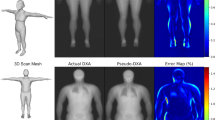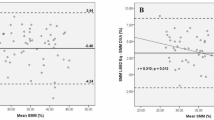Abstract
OBJECTIVE: To evaluate the validity of the Durnin–Womersley equations and to derive our local predictive equations for body fat from upper limb skinfold thicknesses in older Chinese people in Hong Kong. To evaluate the validity of mid-arm circumference and corrected arm muscle area in predicting lean tissue mass in the same population. DESIGN: Comparison of fat percentages predicted by Durnin–Womersley (D–W) equations with those estimated by Dual energy X ray absorptiometry (DXA). Predictive equations derived from regression between upper limb skinfold thicknesses and fat percentages estimated by DXA were similarly evaluated in internal and external validation groups. Mid-arm circumference (MAC) and corrected arm muscle area (CAMA) were correlated with the limb lean tissue mass, body lean tissue mass and fat percentage. SUBJECTS: 354 female and 263 male, apparently well, community dwelling subjects, aged 69–82 y; of which 40 subjects of each sex were randomly selected from the study population for internal validation of the local predictive equations; 60 female and 33 male hospital medical outpatients, aged 61–87 y, were recruited for external validation. MEASUREMENTS: Triceps and biceps skinfold thicknesses, mid-arm circumference, body mass index, fat percentages, limb and whole body lean tissue masses estimated by Hologic QDR-2000 bone densitometer. RESULTS: Fat percentages calculated by D–W equations were significantly different from those estimated by DXA (average difference −2.4 (s.d. 4.8)% and +2.1 (5.2)% in females and males respectively). The corresponding differences for our local predictive equations were not significant (−0.9 (4.7)% and −0.5 (5.0)% in females and males respectively). There was a trend of under‐estimation of body fat with increasing fatness. In the hospital medical outpatients, there was a significant difference between fat percentages predicted by our equation and those by DXA in female (−2.9(5.3)%), but not in male (+0.3(4.3)%) subjects. In males, MAC correlated with limb and body lean tissue masses as well as with fat percentage (r=0.60, 0.68, 0.65 respectively). CAMA correlated similarly well with lean tissue masses but was more independent of fat percentage (r=0.61, 0.65, 0.44 respectively). In females, both MAC and CAMA correlated poorly with limb and body lean tissue masses. Moreover, MAC correlated well with fat percentage (r=0.80). CONCLUSIONS: Upper limb skinfold thicknesses measurement is a valid means of predicting body fat in older Chinese people. Local predictive equations were more reliable that D–W equations. They were, however, subject to errors at the extreme ends of body fatness and in the presence of disease. In older females, MAC and CAMA were not reliable in predicting lean tissue mass, but MAC could be used to predict fat percentages. In older males, CAMA was more reliable than MAC in predicting lean tissue mass.
This is a preview of subscription content, access via your institution
Access options
Subscribe to this journal
Receive 12 print issues and online access
$259.00 per year
only $21.58 per issue
Buy this article
- Purchase on SpringerLink
- Instant access to full article PDF
Prices may be subject to local taxes which are calculated during checkout
Similar content being viewed by others
Author information
Authors and Affiliations
Rights and permissions
About this article
Cite this article
Kwok, T., Woo, J., Chan, H. et al. The reliability of upper limb anthropometry in older Chinese people. Int J Obes 21, 542–547 (1997). https://doi.org/10.1038/sj.ijo.0800438
Received:
Revised:
Accepted:
Issue date:
DOI: https://doi.org/10.1038/sj.ijo.0800438
Keywords
This article is cited by
-
Upper and lower limbs composition: a comparison between anthropometry and dual-energy X-ray absorptiometry in healthy people
Archives of Osteoporosis (2017)
-
Prediction of Body Fat by Anthropometry in Older Chinese People
Obesity Research (2001)



